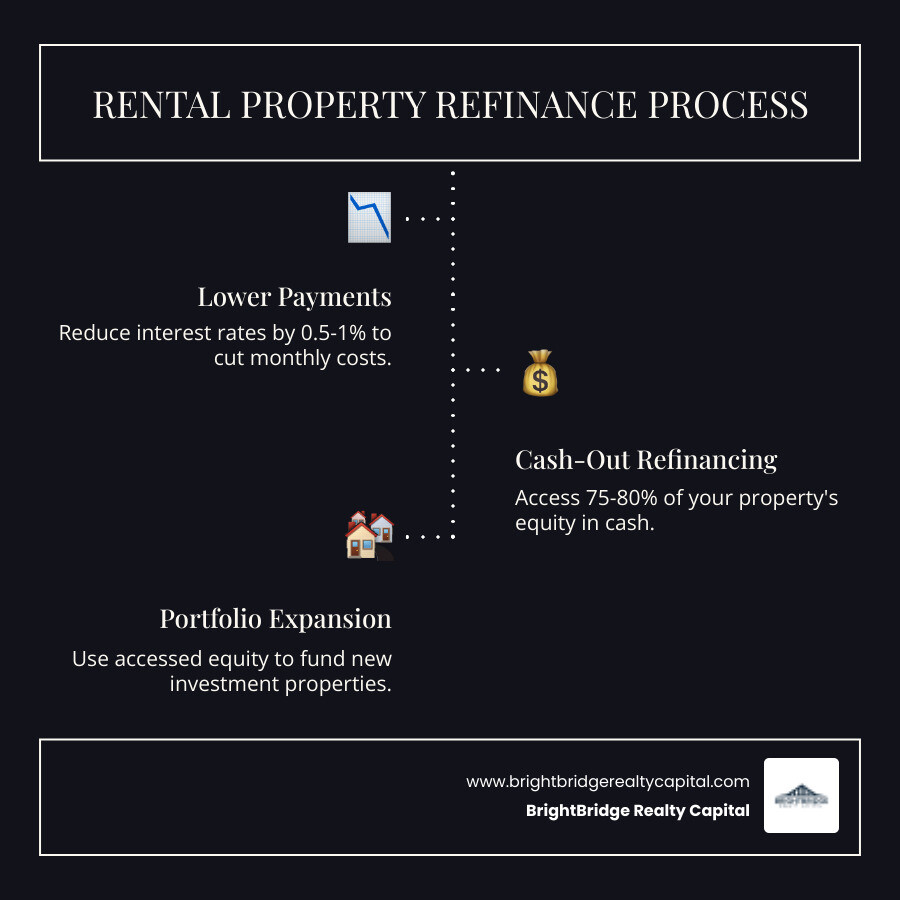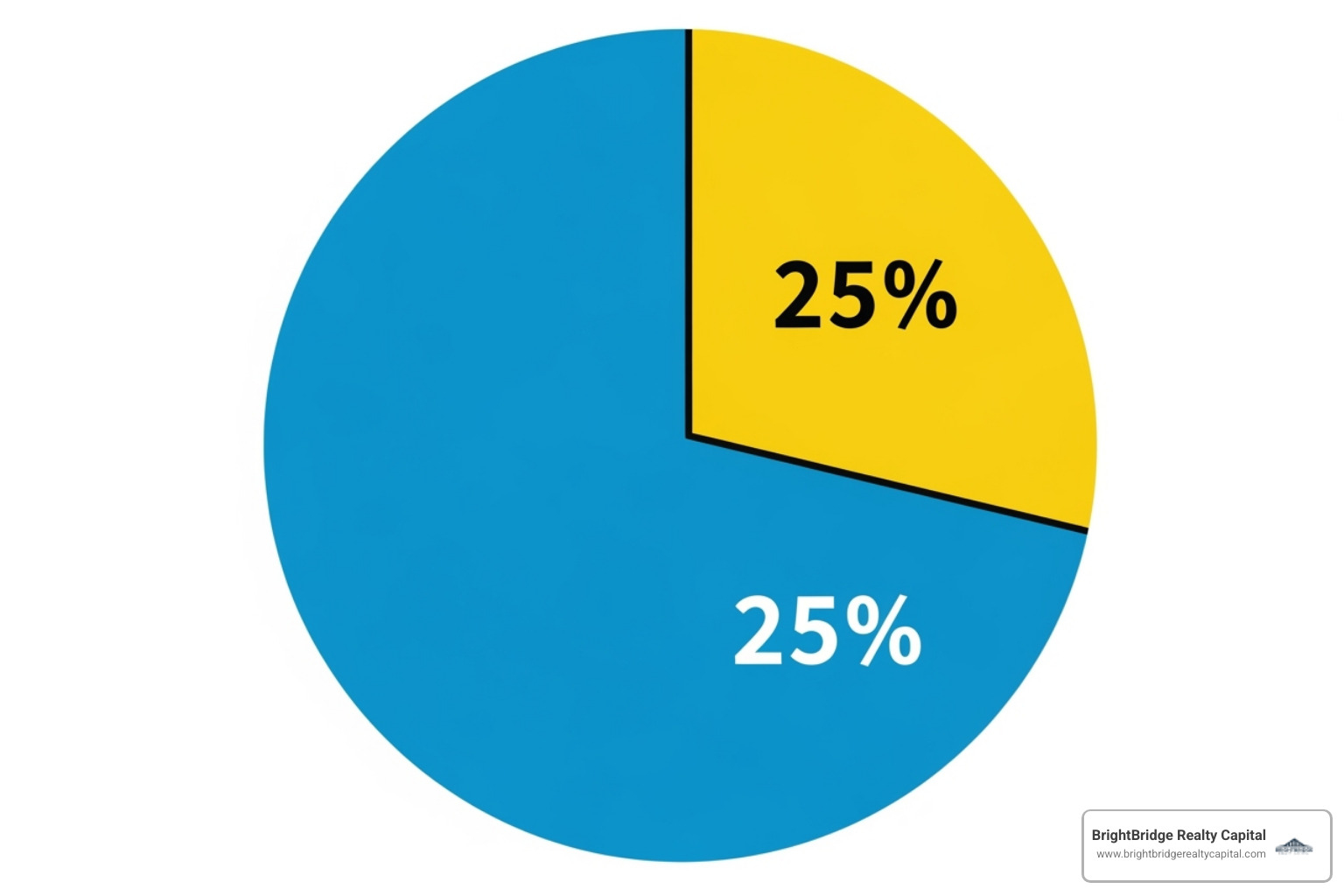Rental Property Refinance: A Smart Move for Investors

Why Rental Property Refinance Makes Financial Sense
Rental property refinance can open up significant value for real estate investors. Here's what you need to know:
Top 3 Benefits:
- Lower monthly payments - Reduce interest rates by 0.5-1%
- Cash-out refinancing - Access 75-80% of property value
- Portfolio expansion - Use equity to fund new investments
Key Requirements:
- Credit score: 620+ minimum (680+ preferred)
- Equity needed: 25-30% minimum
- Cash reserves: 6-12 months of payments
- DTI ratio: 45% maximum
Timeline: 30-60 days from application to closing
Owning an investment property is about maximizing returns. If your current mortgage is hindering profits, refinancing can open up your property's equity, secure better terms, and free up cash for your next investment. Unlike refinancing a primary residence, a rental property refinance has stricter requirements and higher rates because lenders view them as riskier. You'll need stronger financials and more equity to qualify.
I'm Daniel Lopez, a loan officer at BrightBridge Realty Capital. I specialize in helping investors steer the rental property refinance process, structuring deals that open up equity while maintaining strong cash flow.

Rental property refinance vocab explained:
Why Refinance Your Rental Property?
As a real estate investor, refinancing your rental property is a secret weapon for building wealth faster. It can give your investment strategy a turbo boost. If mortgage rates have dropped, you can lower your interest rate, saving significant money over time. You can also change your loan term, such as switching from a 30-year to a 15-year mortgage to save on interest, or extending a term to free up monthly cash flow.
Improving cash flow is often the biggest win. A lower monthly payment puts extra money directly into your pocket. A cash-out refinance also lets you consolidate high-interest debt, rolling credit card balances into your mortgage at a lower rate. A refinance can also fund property improvements like a kitchen renovation, helping you attract better tenants and charge higher rent without draining savings.
Refinancing can also eliminate private mortgage insurance (PMI) once you have 25-30% equity. But the real game-changer is using equity to expand your portfolio. This is how smart investors scale their holdings.
What is a cash-out rental property refinance?
A cash-out refinance lets you tap into your property's equity. You take out a new, larger mortgage, pay off the old one, and receive the difference in cash. This cash at closing can be reinvested into major renovations that boost property value and rental income, like new flooring or updated bathrooms.
Many investors use the funds as a down payment for new properties, leveraging existing equity to grow faster. This strategy helps you grow your real estate portfolio exponentially, turning one property into the foundation for an empire.
How refinancing can increase rental income
Funding upgrades through a refinance can directly boost your rental income, not just lower your mortgage payment. Using refinance cash for renovations helps attract higher-quality tenants willing to pay more for premium features like a modern kitchen.
These improvements justify higher rent. A $15,000 kitchen renovation could increase rent by $200 per month, paying for itself in just over six years while providing long-term income. You're also increasing your property value with each upgrade, building more equity for the future. It's a cycle: refinance, improve, increase rent, build equity, repeat.
The key is maximizing your return on investment. The right upgrades can transform a property into a cash cow. A well-renovated property stays rented longer, attracts better tenants, and commands top-dollar rent. That's how refinancing becomes a tool for increasing income, not just restructuring debt.
Qualifying for a Rental Property Refinance: What Lenders Look For
Getting approved for a rental property refinance is more complex than for a primary home because lenders view investment properties as higher risk. The extra scrutiny comes down to risk. In times of financial stress, homeowners prioritize their primary residence, leading to higher default rates on rental properties. Lenders adjust their requirements accordingly. Understanding what lenders want helps you prepare and position yourself as a strong borrower.
Financial Health and Credit Score
Your financial health is the foundation for approval. Lenders scrutinize your credit, income, and debt management. While a 580 score might work for an FHA loan, rental property lenders typically require a 620 minimum credit score. For the best rates, aim for 680 or higher. Some lenders require 700+ for cash-out refinances.
Debt-to-income (DTI) ratios are tighter, typically capped at 45%. A DTI of 36% or less is ideal, showing you can handle payments even with fluctuating rental income.
Cash reserves are non-negotiable. Lenders require 6 to 12 months of mortgage payments in reserves for each rental property. This demonstrates you can cover expenses during vacancies or repairs.
Equity and Loan-to-Value (LTV) Ratio

Your equity is critical, as it determines qualification, cash-out amounts, and your interest rate. Lenders require more skin in the game: a 25% to 30% equity minimum. This is higher than the 20% for primary homes due to increased risk. You'll need to maintain at least 20-25% equity after closing.
The 75% loan-to-value (LTV) rule is common. Lenders cap loans at 75% of the appraised value, ensuring a 25% equity cushion. Understanding home equity is crucial for planning, as more equity means more flexibility.
The appraisal is more detailed for rentals. It includes a rent schedule analysis to assess income potential, which is a key factor in the lender's risk assessment.
Interest Rates and Loan Terms
The biggest difference is the cost of borrowing. Expect higher interest rates, typically 0.50% to 0.875% higher than for primary residences. This is the cost of investing, but the benefits often outweigh it. Paying discount points to lower your rate can make sense for long-term holds.
The choice between fixed-rate and adjustable-rate mortgages (ARMs) is critical. Fixed rates offer predictable payments, making cash flow projections easier. ARMs have lower initial payments but risk future payment shock.
Loan terms affect your strategy. Shorter terms (15-20 years) build equity faster but have higher payments. Longer terms improve cash flow but cost more in total interest. The choice depends on your goals.
Want to explore specific loan programs designed for investors? Check out our rental loan programs to see what options might work best for your situation.
The Step-by-Step Refinance Process
Ready to refinance your rental property? The process follows a predictable path. Most refinances take 30 to 60 days, much of which involves behind-the-scenes work by your lender. The process has three phases: documentation, application, and closing. Let's walk through each step.
Step 1: Gather Key Documents for Your Rental Property Refinance Application
Lenders need a full picture of your finances and the property's income potential. You'll need two years of W-2s or 1099s, recent pay stubs, and complete federal tax returns. Your Schedule E (Form 1040) is crucial, as it shows your rental income or loss, which lenders use for verification.
Two months of bank statements demonstrate your cash reserves and asset stability. Property-specific documentation is also needed, including current mortgage statements for all properties, lease agreements to prove income, and your homeowners insurance policy. You'll also need a valid ID and the property's deed. Be prepared to explain any credit issues, income gaps, or large deposits.
Step 2: Compare Lenders and Apply
Choosing the right lending partner can save you thousands. Shop for rates from at least three to five lenders. A small rate difference means significant savings, but the lowest rate isn't always the best deal if it includes high fees or a slow lender.
Working with direct lenders like BrightBridge Realty Capital offers advantages over traditional banks. We specialize in investor financing, offering flexible solutions, a streamlined process, and competitive rates by cutting out intermediaries.
After choosing a lender, submit your application. Then, consider locking your interest rate for 15 to 60 days to protect against market fluctuations.
Ready to explore your options? Connect with a BrightBridge loan specialist who understands the investor mindset.
Step 3: Underwriting and Closing
In this final phase, your lender verifies all your information and prepares for closing. During underwriting, your lender will pull your credit, verify employment and income, and review assets. They will order an appraisal, which for rentals includes a rent schedule to assess income potential. A title search will also be conducted to check for liens.
The Closing Disclosure arrives at least three business days before closing. Review this document carefully, as it details all final loan terms. This is your last chance to ask questions.
On signing day, you'll sign the final loan documents. A bonus for investors: there's no three-day right of rescission period, meaning you can get your funds faster. The process takes 30 to 60 days, but good preparation and the right lender can speed it up.
Ready to take the next step? Start the mortgage refinance process with BrightBridge Realty Capital and experience the difference that specialized investor financing can make.
Crunching the Numbers: Key Financial Calculations
For real estate investors, every decision is about the numbers. A rental property refinance requires a deep dive into the financial calculations to determine if it makes sense for your portfolio. The reality is that closing costs for a rental property refinance are typically 2% to 6% of the loan amount. On a $300,000 loan, that's $6,000 to $18,000. The key is to determine if these upfront costs will pay for themselves by analyzing the long-term return on investment (ROI).
Calculating Your Break-Even Point
The break-even point is the most important calculation. It tells you how long it will take to recoup your closing costs through monthly savings.
The formula is simple: Break-Even Point (in months) = Total Closing Costs ÷ Monthly Savings
For example, if your total closing costs are $8,000 and your new loan saves you $200 per month:
Break-Even Point = $8,000 ÷ $200 = 40 months (or about 3.3 years)
This means you need to hold the property for 40 months to recoup your expenses. After that, every month's savings is pure profit. For long-term profitability, if you keep the property for 10 years, you'll have 80 months of savings after breaking even, totaling an extra $16,000.
Comparing the Pros and Cons of Refinancing
A rental property refinance has both pros and cons that investors must weigh carefully.
| Pros | Cons |
|---|---|
| Lower monthly payment | Closing costs |
| Access to cash (equity) | Stricter lending requirements |
| Better loan terms | Higher interest rates than primary homes |
| Fund portfolio growth | Resets the amortization clock |
| Eliminate PMI | Potential for appraisal issues |
Let's break down what these mean for your bottom line.
Pros: A lower monthly payment improves cash flow. Accessing cash through equity can fund renovations or a down payment on another property. Better loan terms could mean switching to a predictable fixed rate. The ability to fund portfolio growth is a powerful benefit. Eliminating PMI saves you money every month.
Cons: The main challenge is closing costs. You'll face stricter lending requirements and higher interest rates than for a primary residence. Resetting the amortization clock is a key consideration, as you start your payoff timeline over. Finally, potential appraisal issues can disrupt your plans if the value comes in low.
The key is to weigh these factors against your specific goals. A refinance that's right for one investor may not be for another.
Beyond Refinancing: Additional Ways to Leverage Equity with BrightBridge
While a rental property refinance is a great way to access equity, it's not the only option. At BrightBridge Realty Capital, we offer alternative financing solutions for investors who need fast capital or when a full refinance isn't the right fit.

Our DSCR loans are a game-changer. They focus on the property's ability to pay for itself (the Debt Service Coverage Ratio) rather than your personal income. This is ideal for investors who want to expand quickly without traditional income verification. The speed is powerful: while a traditional refinance can take 30-60 days, our DSCR loans can close in as little as a week, helping you secure time-sensitive opportunities.
Our customized loan programs go beyond a one-size-fits-all approach. Whether you need bridge financing or have a unique multi-property situation, as direct lenders, we can structure a deal that fits your needs. Working with us eliminates the middleman, meaning faster decisions, clear communication, and competitive rates.
Other market options include home equity loans (lump sum, fixed payments) and home equity lines of credit (flexible draw). Portfolio loans can consolidate multiple properties under one loan. The right choice depends on your goals. For a time-sensitive deal, our fast-closing options are ideal. For a long-term renovation, a line of credit offers flexibility.
Ready to explore your options? Explore our DSCR loan options and find how we can help you leverage your equity more effectively than traditional refinancing alone.
Conclusion: Is Refinancing Your Rental Property the Right Move?
Is a rental property refinance right for you? It depends on your specific situation and goals. Think of refinancing as a strategic tool; it works brilliantly in some situations but not others.
The benefits are substantial: lower monthly payments improve cash flow, access to equity fuels growth, and better loan terms provide flexibility. However, remember the costs and considerations: closing costs of 2-6%, stricter lending requirements, and higher interest rates are part of the landscape.
The key is to run the numbers. Calculate your break-even point. If you plan to hold the property long-term, refinancing often makes sense. If you plan to sell soon, the costs may outweigh the benefits.
Your decision should align with your wealth-building strategy. Whether you want to improve cash flow, fund improvements, or access equity to expand, refinancing can be a smart move.
At BrightBridge Realty Capital, we help investors steer these decisions. The most successful investors understand all their options before acting. We specialize in providing fast and flexible financing solutions designed specifically for real estate investors like you.
Ready to explore your options? For fast and flexible financing solutions custom to real estate investors, consider BrightBridge Realty Capital.
- Explore our DSCR loan options and find how we can help accelerate your real estate investment journey.




